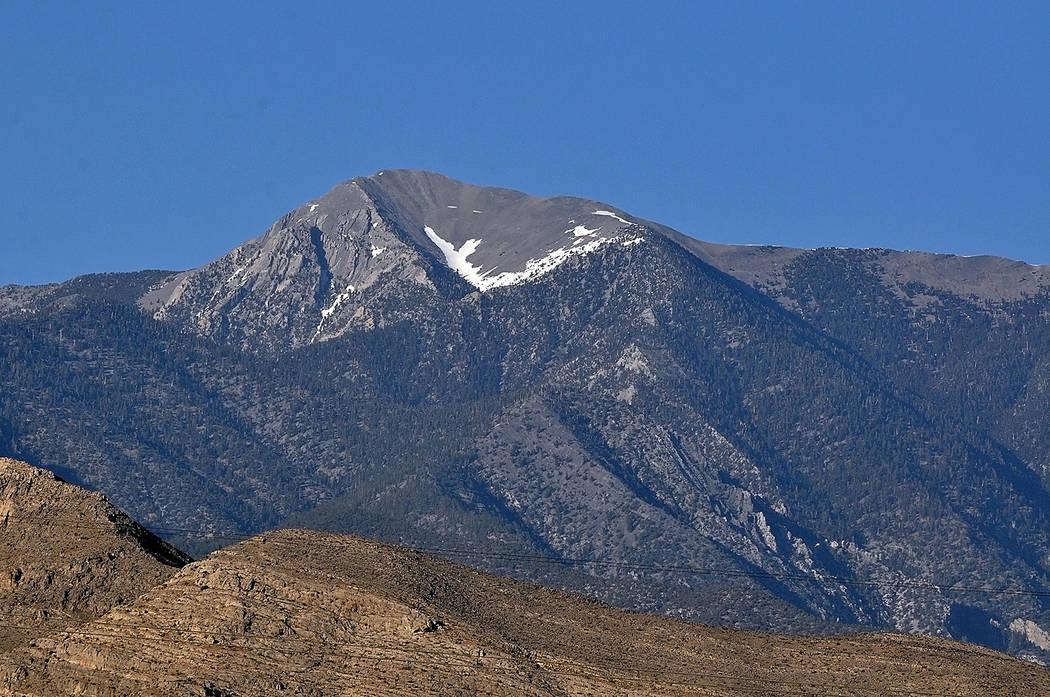Pahrump-area snowmelt brings back memories of pioneering family
About this time each year, I take special pleasure in driving on Highway 160 at the far south end of Pahrump between Manse Road and Gamebird Road.
In this season, the typical snowmelt is well underway high on Mount Charleston and creates a most interesting melt pattern. Toward the top of the west side of this magnificent peak the remaining snow forms, for a time, a large, well-shaped letter Y.
I find it especially interesting that this great letter of snow looks down on the site of the old Manse Ranch.
That ranch, of course, was developed by Joseph and Margaret Yount and their family beginning in 1876, and for a time it was the showplace of Southern Nevada. The big Y formed of unmelted snow on Mount Charleston in the spring makes me wonder if it is Mother Nature’s way of honoring the Yount family for their outsized contributions to life in Southern Nevada.
Manse Ranch
My understanding of regional history suggests that the Manse Ranch represents the real beginnings of Euroamerican society in Southern Nevada, including the Las Vegas Valley.
The Younts were amazing people and they, more than any other early settlers, made a full-bore, long-term commitment to the economic and social development of life in this part of Nevada. They operated a huge ranch, farmed, mined, produced lumber in their own sawmill, entertained socially, and provided lodging for travelers.
One traveler who passed through Pahrump Valley in 1886 described the Manse Ranch as follows: “A fertile spot, ornamented with fragrant flowers, evergreens, and every useful product for the comfort and use of man and beast, orchards and vineyards, preserves, raisins and wine, turkeys, ducks, chickens, and geese to the number of 400, fish swimming pools, large and long, which have 100 inches of warm water constantly flowing through them.”
That traveler wrote the Yount farm was capable of producing better quality food than could be purchased anywhere else in Nevada or even in Los Angeles.
And he described Margaret Yount: “Too much praise cannot be given the precious mother, Mrs. Yount, who has raised five sons and five daughters here. And though the church, and the schoolhouse and the tick of the telegraph was far away from their oasis home, intelligence and civilization are there, after nature’s own design, and void of the superfluous vanity with which the masses are burdened.”
Yount family history
Joseph Yount was born in 1818 in Knox County, Missouri. He was a frontiersman and served in the Mexican War under General Stephen Kearney. In 1849 he went to California with the Gold Rush. In 1853, upon his return to Missouri, he married Margaret Parent. Yount was later chosen captain of a train of 100 wagons headed for Oregon.
In 1876, Joseph and Margaret and their family were living in La Grange, Oregon. They heard about the gold strike in Tombstone, Arizona; Joseph knew the discoverer. Pioneers at heart, the family decided to move to Tombstone. They sold off their holdings in Oregon, assembled 400 head of cattle, 30 horses, and two covered wagons and headed south. They were accompanied by their children, ranging in age from one to 17 years; their daughter Maude and her husband, Harsha White; and the Whites’ one-year-old daughter, Della May.
While on the road, Yount changed his mind about Tombstone and decided to head for Southern California. He chose a route that took him past the Groom Mine, then to Indian Springs and Ash Meadows.
They camped in Ash Meadows and took their horses to the mountains to graze at a location not far from the future site of the Johnnie Mine. Joseph went to Tecopa for supplies and upon his return was horrified to find the Indians had killed all his draft horses. The Indians identified the draft horses by the collar marks on their necks. The Indians knew if they killed the draft horses, they could poach on the Younts’ cattle at their leisure. With no horses to pull their wagons, the Younts were stranded in the wilderness.
Cattle traded for the ranch
Joseph Yount learned, after talking to Charles Bennet at what became the Pahrump Ranch, that there were no draft horses for sale but that he might trade cattle for a small undeveloped ranch located six miles south owned by three Jordan brothers. They had about eight acres under cultivation. Yount checked it out and made the trade. The house on the property was the Yount family’s new home. It consisted of a 12x14 structure made of posts in the ground and willows nailed to them and a sod roof and floor.
Yount broke his saddle horses and immediately began cultivating the land, selling the first year’s production at the Tecopa Mine, 30 miles away.
Such was the beginning of the Manse Ranch, Southern Nevada’s first showplace.
Just as Mother Nature seems to be honoring the Yount family’s achievements each year with her snowmelt pattern high on Mount Charleston, perhaps the Pahrump community could put a plaque or even a statue at the site of the Manse Ranch or perhaps in the Pahrump Valley Museum to honor the Younts’ huge role in the development of Pahrump.
Perhaps a series of plaques could be developed to honor other key contributors to Pahrump’s development.
Bob McCracken has a doctorate in cultural anthropology and is the author of numerous books in the Nye County Town History Project.

















